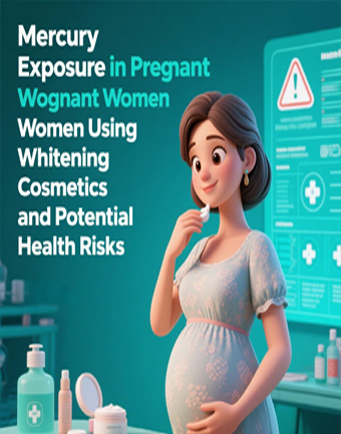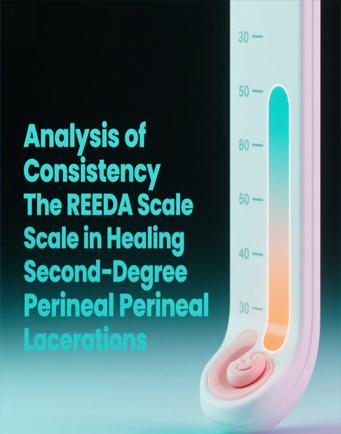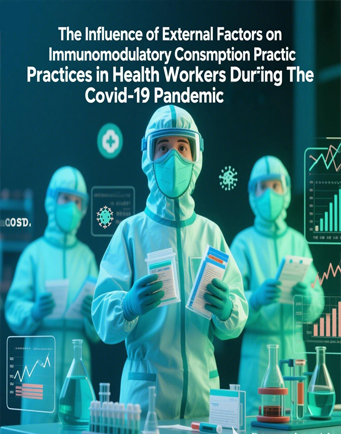Comparison of Macronutrient and Micronutrient Adequacy Among Pregnant Women in Urban and Rural Areas
Downloads
Adequate macronutrients and micronutrients during pregnancy can support optimal fetal growth and development in addition to meeting the needs of the mother to ensure a healthy pregnancy. The region of residence is one of the factors that contribute to determining how nutrition is fulfilled in groups of pregnant women. This study aims to compare the adequacy of macronutrients and micronutrients between pregnant women in urban and rural areas. This study involved 50 pregnant women, 25 in urban areas and 25 in rural areas. Nutritional information was obtained using a food recall questionnaire that was assessed for 3 days, namely on 2 working days (not consecutive) and 1 day off and also using a food frequency questioner (FFQ). Data was analyzed using Chi Square and Results showed a difference in carbohydrate (p=0.049) and protein (p=0.045) consumption between urban and rural pregnant women, while energy (p=0.053) and fat (p=0.056) showed no difference in adequacy. For micronutrients, Vitamin A (p=0.043) and B12 (p=0.042) consumption showed differences between urban and rural pregnant women, while for vitamin C (p=0.065), vitamin B1 (p=0.078), vitamin B2 (p=0.084), B3 (p=0.056), B6 (p=0.075), E (p=0.088), Iron (p=0.052), Folic acid (p=0.067), Calcium (p=0.054), Phosphorus (p=0.055), fiber (p=0.079), showed no difference in consumption between urban and rural pregnant women. The consumption of micronutrients and macronutrients of pregnant women in rural and urban areas showed less intake than recommended. Nutrition education needs to be improved not only focusing on pregnant women but also on adolescent groups, pre-conception period so that early on good consumption patterns have been formed which will always be applied throughout life.
Abay, A., Yalew, H. W., Tariku, A., & Gebeye, E. (2017). Determinants of prenatal anemia in Ethiopia. Archives of Public Health, 75(1), 1–10. https://doi.org/10.1186/s13690-017-0215-7
Adikari, A. M. N. T., Sivakanesan, R., Wijesinghe, D. G. N. G., & Liyanage, C. (2016). Assessment of nutritional status of pregnant women in a rural area in Sri Lanka. Tropical Agricultural Research, 27(2), 203. https://doi.org/10.4038/tar.v27i2.8168
Ali, F., Thaver, I., & Khan, S. A. (2014). Original Article Assessment Of Dietary Diversity And Nutritional Status Of Pregnant Women In Islamabad , Pakistan Fatima Ali , Inayat Thaver , Shahzad Ali Khan. J Ayub Med Coll Abbottabad, 26(4), 506–509.
Argyridis, S. (2019). Folic acid in pregnancy. Obstetrics, Gynaecology and Reproductive Medicine, 29(4), 118–120. https://doi.org/10.1016/j.ogrm.2019.01.008
Ariyani, N. W., & Erawati, N. L. P. S. (2023). Assessment of nutrient intake and antenatal education method for pregnant women in Gianyar, Bali, Indonesia. Bali Medical Journal, 12(1), 934–939. https://doi.org/10.15562/bmj.v12i1.4194
Asmar. (2022). Hasil Analisis Data Pengukuran Stunting Tingkat Kota Palopo. Ritmee. Retrieved from https://ritmee.co.id/hasil-analisis-data-pengukuran-stunting-tingkat-kota-palopo/. 2022
Astika, T., Permatasari, E., Rizqiya, F., Kusumaningati, W., Indraaryani, I., & Hermiwahyoeni, Z. (2021). Pengaruh pendidikan gizi dan kesehatan reproduksi ibu hamil di Indonesia menggunakan studi eksperimental semu. 1–15.
Blumfield, M. L., Hure, A. J., MacDonald-Wicks, L., Smith, R., & Collins, C. E. (2013). A systematic review and meta-analysis of micronutrient intakes during pregnancy in developed countries. Nutrition Reviews, 71(2), 118–132. https://doi.org/10.1111/nure.12003
Cannon, S., Lastella, M., Vincze, L., Vandelanotte, C., & Hayman, M. (2020). A review of pregnancy information on nutrition, physical activity and sleep websites. Women and Birth, 33(1), 35–40. https://doi.org/10.1016/j.wombi.2018.12.007
Cave, C., Hanson, C., Schumacher, M., Lyden, E., Furtado, J., Obaro, S., Delair, S., Kocmich, N., Rezac, A., Izevbigie, N. I., Van nOrmer, M., Kamil, A., McGinn, E., Rilett, K., Elliott, E., Johnson, R., Weishaar, K., Olateju, E. K., Akaba, G. A., … Anderson-Berry, A. (2018). A comparison of vitamin E status and associated pregnancy outcomes in maternal–infant dyads between a Nigerian and a United States population. Nutrients, 10(9), 1–14. https://doi.org/10.3390/nu10091300
Čvorović, J. (2022). Maternal age at marriage and child nutritional status and development: evidence from Serbian Roma communities. Public Health Nutrition, 25(5), 1183–1193. https://doi.org/10.1017/S1368980022000544
Faber, M., Kunneke, E., Wentzel-Viljoen, E., & Wenhold, F. (2016). Dietary Intake Assessment 24-Hour Recall Compiled By: Dietary intake assessment 24-hour recall Dietary intake assessment: 24-hour recall. http://www.cdc.gov/nchs/nhanes/measuring_guides_dri/measuringguides02.htm
Forbes, L. E., Graham, J. E., Berglund, C., & Bell, R. C. (2018). Dietary change during pregnancy and women’s reasons for change. Nutrients, 10(8), 1–10. https://doi.org/10.3390/nu10081032
Fuada, N., Latifah, L., Yunitawat, D., & Ashar, H. (2020). Assessment of nutritional status of children under-five in families of adolescent mothers in Indonesia 2013. Journal of Nutritional Science and Vitaminology, 66(29), S425–S431. https://doi.org/10.3177/jnsv.66.S425
Grenier, L. N., Atkinson, S. A., Mottola, M. F., Wahoush, O., Thabane, L., Xie, F., Vickers-Manzin, J., Moore, C., Hutton, E. K., & Murray-Davis, B. (2021). Be Healthy in Pregnancy: Exploring factors that impact pregnant women’s nutrition and exercise behaviours. Maternal and Child Nutrition, 17(1), 1–9. https://doi.org/10.1111/mcn.13068
Grieger, J. A., Grzeskowiak, L. E., & Clifton, V. L. (2014). Preconception dietary patterns in human pregnancies are associated with preterm delivery. Journal of Nutrition, 144(7), 1075–1080. https://doi.org/10.3945/jn.114.190686
Haider, B. A., & Bhutta, Z. A. (2017). Multiple-micronutrient supplementation for women during pregnancy ( Review ) Summary Of Findings For The Main Comparison. Cochrane Database of Systematic Reviews, 4(4), CD004905. https://doi.org/10.1002/14651858.CD004905.pub5
Kazma, J. M., van den Anker, J., Allegaert, K., Dallmann, A., & Ahmadzia, H. K. (2020). Anatomical and physiological alterations of pregnancy. Journal of pharmacokinetics and pharmacodynamics, 47(4), 271-285. https://doi.org/10.1007/s10928-020-09677-1
Keats, E. C., Haider, B. A., Tam, E., & Bhutta, Z. A. (2019). Multiple-micronutrient supplementation for women during pregnancy. Cochrane Database of Systematic Reviews, 2019(3). https://doi.org/10.1002/14651858.CD004905.pub6
Kementerian Kesehatan Republik Indonesia. (2013). Buku Saku Pelayanan Kesehatan Ibu Di Fasilitas Kesehatan Dasar Dan Rujukan, Kementerian Kesehatan Republik Indonesia.
Kementerian Kesehatan Republik Indonesia. (2018). Hasil Riset Kesehatan Dasar Tahun 2018. Kementerian Kesehatan Republik Indonesia.
Kiboi, W., Kimiywe, J., & Chege, P. (2017). Determinants of dietary diversity among pregnant women in Laikipia County, Kenya: A cross-sectional study. BMC Nutrition, 3(1), 1–8. https://doi.org/10.1186/s40795-017-0126-6
Hardinsyah, M., & Supariasa, I. D. N. (2016). Ilmu gizi teori dan aplikasi. Jakarta: Penerbit Buku Kedokteran EGC.
Mousa, A., Naqash, A., & Lim, S. (2019). Macronutrient and micronutrient intake during pregnancy: An overview of recent evidence. Nutrients, 11(2), 1–20. https://doi.org/10.3390/nu11020443
Nana, A., & Zema, T. (2018). Dietary practices and associated factors during pregnancy in northwestern Ethiopia. BMC Pregnancy and Childbirth, 18(1), 1–8. https://doi.org/10.1186/s12884-018-1822-1
Nigatu, M., Gebrehiwot, T. T., & Gemeda, D. H. (2018). Household Food Insecurity, Low Dietary Diversity, and Early Marriage Were Predictors for Undernutrition among Pregnant Women Residing in Gambella, Ethiopia. Advances in Public Health, 2018, 1–10. https://doi.org/10.1155/2018/1350195
Nugrahini, E. Y., Effendi, J. S., Herawati, D. M. D., Idjradinata, P. S., Sutedja, E., Mose, J. C., & Syukriani, Y. F. (2014). Asupan Energi dan Protein Setelah Program Pemberian Makanan Tambahan Pemulihan Ibu Hamil Kurang Energi Kronik di. IJEMC (Journal Of Education and Midwifery Care), 1(1), 41–48.
Paknahad, Z., Fallah, A., & Moravejolahkami, A. R. (2019). Maternal Dietary Patterns and Their Association with Pregnancy Outcomes. Clinical Nutrition Research, 8(1), 64. https://doi.org/10.7762/cnr.2019.8.1.64
Permatasari, T. A. E., Rizqiya, F., Kusumaningati, W., Suryaalamsah, I. I., & Hermiwahyoeni, Z. (2021). The effect of nutrition and reproductive health education of pregnant women in Indonesia using quasi experimental study. BMC Pregnancy and Childbirth, 21(1), 1–15. https://doi.org/10.1186/s12884-021-03676-x
Quansah, D. Y., & Boateng, D. (2020). Maternal dietary diversity and pattern during pregnancy is associated with low infant birth weight in the Cape Coast metropolitan hospital, Ghana: A hospital based cross-sectional study. Heliyon, 6(5), e03923. https://doi.org/10.1016/j.heliyon.2020.e03923
Qureshi, Z., & Khan, R. (2015). Diet Intake Trends Among Pregnant Women in Rural Area of Rawalpindi, Pakistan. Journal of Ayub Medical College, Abbottabad : JAMC, 27(3), 684–688.
Retni, R., Margawati, A., & Widjanarko, B. (2016). Pengaruh status gizi & asupan gizi ibu terhadap berat bayi lahir rendah pada kehamilan usia remaja. Jurnal Gizi Indonesia (The Indonesian Journal of Nutrition), 5(1), 14–19. https://doi.org/10.14710/jgi.5.1.14-19
Royani, I., Mappaware, N. A., Darma, S., Khalid, N., & Utami, D. F. (2021). The Relationship between Nutritional Status of Pregnant Women and Stunted Children. Green Medical Journal, 3(1), 39–46. https://doi.org/10.33096/gmj.v3i1.80
Saaka, M., Mutaru, S., & Osman, S. M. (2021). Determinants of dietary diversity and its relationship with the nutritional status of pregnant women. Journal of Nutritional Science, 1–8. https://doi.org/10.1017/jns.2021.6
Samsury, S. F., Ismail, T. A. T., & Hassan, R. (2022). Low birth weight infant among teenage pregnancy in Terengganu, Malaysia: A cross-sectional study. Malaysian Family Physician, 17(1), 44–51. https://doi.org/10.51866/oa.59
Sendeku, F. W., Azeze, G. G., & Fenta, S. L. (2020). Adherence to iron-folic acid supplementation among pregnant women in Ethiopia: A systematic review and meta-analysis. BMC Pregnancy and Childbirth, 20(1), 1–9. https://doi.org/10.1186/s12884-020-2835-0
Sibhatu, K. T., Krishna, V. V., & Qaim, M. (2015). Production diversity and dietary diversity in smallholder farm households. Proceedings of the National Academy of Sciences of the United States of America, 112(34), 10657–10662. https://doi.org/10.1073/pnas.1510982112
Stråvik, M., Jonsson, K., Hartvigsson, O., Sandin, A., Wold, A. E., Sandberg, A. S., & Barman, M. (2019). Food and nutrient intake during pregnancy in relation to maternal characteristics: Results from the nice birth cohort in northern Sweden. Nutrients, 11(7). https://doi.org/10.3390/nu11071680
Sudfeld, C. R., & Smith, E. R. (2019). New evidence should inform WHO guidelines on multiple micronutrient supplementation in pregnancy. Journal of Nutrition, 149(3), 359–361. https://doi.org/10.1093/jn/nxy279
Suliga, E. (2015). Nutritional behaviours of pregnant women in rural and urban environments. Annals of Agricultural and Environmental Medicine, 22(3), 513–517. https://doi.org/10.5604/12321966.1167725
Symons Downs, anielle. (2014). Falling Short of Guidelines? Nutrition and Weight Gain Knowledge in Pregnancy. Journal of Women’s Health Care, 03(05). https://doi.org/10.4172/2167-0420.1000184
WHO. (2018). WHO Recommendation on Antenatal Care for a Positive Pregnancy Experience: Summary. The Lancet, 387(10017), 1–10. https://doi.org/10.1186/1742-4755-10-19.5
Yeneabat, T., Adugna, H., Asmamaw, T., Wubetu, M., Admas, M., Hailu, G., Bedaso, A., & Amare, T. (2019). Maternal dietary diversity and micronutrient adequacy during pregnancy and related factors in East Gojjam Zone, Northwest Ethiopia, 2016. BMC Pregnancy and Childbirth, 19(1), 1–9. https://doi.org/10.1186/s12884-019-2299-2
Yosephin, B. (2018). Tuntunan Praktis Menghitung Kebutuhan Gizi. Yogyakarta: Andi. Retrieved from https://pustaka.pekanbaru.go.id/inlislite3/opac/detail-opac?id=28395
Copyright (c) 2024 JURNAL INFO KESEHATAN

This work is licensed under a Creative Commons Attribution-NonCommercial-ShareAlike 4.0 International License.
Copyright notice
Ownership of copyright
The copyright in this website and the material on this website (including without limitation the text, computer code, artwork, photographs, images, music, audio material, video material and audio-visual material on this website) is owned by JURNAL INFO KESEHATAN and its licensors.
Copyright license
JURNAL INFO KESEHATAN grants to you a worldwide non-exclusive royalty-free revocable license to:
- view this website and the material on this website on a computer or mobile device via a web browser;
- copy and store this website and the material on this website in your web browser cache memory; and
- print pages from this website for your use.
- All articles published by JURNAL INFO KESEHATAN are licensed under the Creative Commons Attribution 4.0 International License. This permits anyone to copy, redistribute, remix, transmit and adapt the work provided the original work and source is appropriately cited.
JURNAL INFO KESEHATAN does not grant you any other rights in relation to this website or the material on this website. In other words, all other rights are reserved.
For the avoidance of doubt, you must not adapt, edit, change, transform, publish, republish, distribute, redistribute, broadcast, rebroadcast or show or play in public this website or the material on this website (in any form or media) without appropriately and conspicuously citing the original work and source or JURNAL INFO KESEHATAN prior written permission.
Permissions
You may request permission to use the copyright materials on this website by writing to jurnalinfokesehatan@gmail.com.
Enforcement of copyright
JURNAL INFO KESEHATAN takes the protection of its copyright very seriously.
If JURNAL INFO KESEHATAN discovers that you have used its copyright materials in contravention of the license above, JURNAL INFO KESEHATAN may bring legal proceedings against you seeking monetary damages and an injunction to stop you using those materials. You could also be ordered to pay legal costs.
If you become aware of any use of JURNAL INFO KESEHATAN copyright materials that contravenes or may contravene the license above, please report this by email to jurnalinfokesehatan@gmail.com
Infringing material
If you become aware of any material on the website that you believe infringes your or any other person's copyright, please report this by email to jurnalinfokesehatan@gmail.com.





































